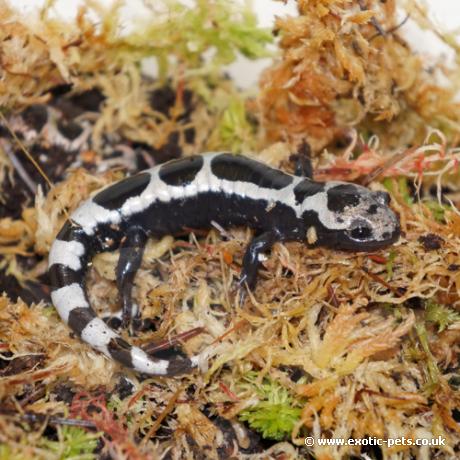

Part of the amphibian group commonly known as the mole salamanders. This species is both fascinating and easy to keep and house.
| Origin | United States (Eastern) |
|---|---|
| Environment | Damp woodland, forests and hillsides |
| Adult Size | 8-11cm |
| Suitability | Novice |
| Lifespan | 8-10 years |
A small, plump and attractive salamander which has a smooth dark grey to black base colouration with broad alternating bands of white or silvery grey across the dorsal (back). The venter (underside) is typically grey in colour.
Interestingly, Ambystoma opacum do have some distinct sexual differences. The males will of course possess swollen cloaca during the breeding season like many other salamander species, but they can also be separated year-round by their band colouration. Males have whiter bands and females silvery grey.
Most specimens will reach lengths between 8-11cm.
Found throughout the eastern United States from New Hampshire, south to northern Florida, and as far west as Missouri, south to eastern Texas.
In the wild, Marbled Salamanders are common but secretive and population sizes can range from dozens into the hundreds in localised regions.
Their natural habitat year-round consists of seasonal wetlands and intact forested floodplains. It is presumed, that some local decline will have occurred in some regions, due to habitat destruction and their reliance on these areas for breeding.
House salamanders singularly or in small groups (if enough space is provided). Aggression between conspecifics (members of the same species) is possible, particularly the males. This can lead to severe problems; loss of appetite, stress and risk of infection due to fighting. If housing in groups, you must provide adequate space and monitor individuals carefully.
Glass terrariums or plastic tanks are the prefered choice of housing. Expensive heating or lighting equipment is not necessary for Marbled Salamanders. Providing UVB is optional, but we would recommend providing a low percentage lamp only of 2-5%. The use of an overhead canopy combined with a compact style UVB bulb is the easiest way to achieve this. Maintain temperatures between 18°C (65°F) and 24°C (75°F) throughout the year, but with a winter temperature drop to replicate natural seasonal changes. Measure temperatures with a good digital thermometer.
Provide a minimum substrate layer of 7-10cm. This must be soil based and kept damp but not waterlogged. The use of sphagnum moss is also beneficial and helps retain humidity. Add other natural decor such as rocks, bark and logs for the salamanders to hide under.
Provide a water dish large enough for drinking but remember that all water should be treated with a good quality dechlorinator to remove any harmful chemicals.
Livefood should be offered in the form of Crickets, Curly-wing flies, Earthworms and Waxworms. Choosing the correct size insect is important, if they are too large they will be ignored. For adult Marbled Salamanders don’t attempt to feed crickets larger than small/medium in size. Remember, that you must ensure all of your insects are well gutloaded before feeding them to your animals.
Offer livefood to your salamanders two or three times a week and remove any uneaten food by the next morning. Temperatures will influence how often and how much you feed your salamander. Use personal judgement to ensure most of the food offered is being consumed. As a guideline, most salamanders won’t eat more than 8-12 crickets a week.
Lastly and most importantly you must use a good quality dusting powder to provide essential calcium and vitamins to your salamanders. The traditional method of application is to use a spare livefood tub or empty cereal container to coat the insects lightly in whichever dusting powder you are using. Dust your insects on every other feed and offer vitamins at least every couple of weeks.